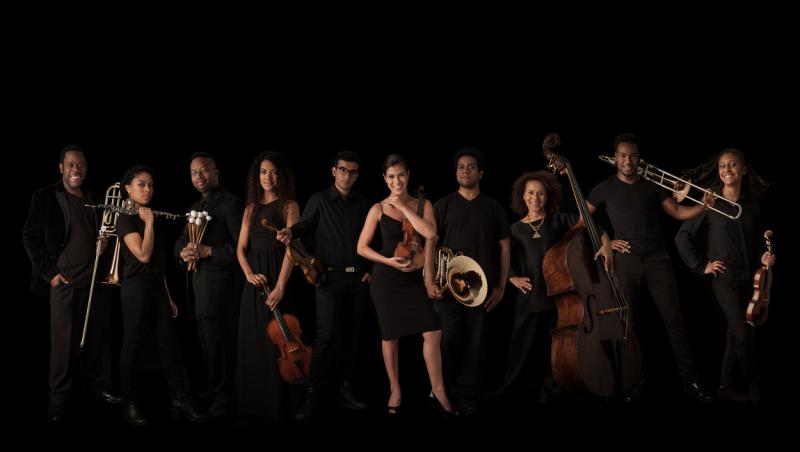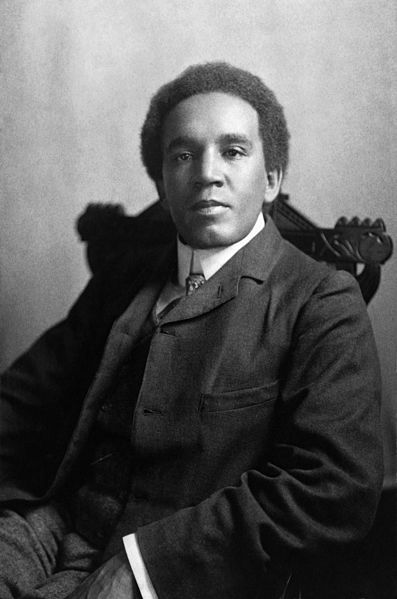Chineke! Ensemble, RNCM, Manchester review - musical advocacy | reviews, news & interviews
Chineke! Ensemble, RNCM, Manchester review - musical advocacy
Chineke! Ensemble, RNCM, Manchester review - musical advocacy
A ground-breaking group in chamber music with a difference

The Chineke! Orchestra has won golden opinions for its ground-breaking work and musical achievement, and Manchester caught up to the extent of a visit from the eight-person Chineke! Ensemble to the Royal Northern College of Music.
There are more points of exposure for a chamber group than might be the case with a larger ensemble, so in some ways the challenge was a big one for Chi-chi Nwanoku and her colleagues. One real plus point was their success in getting an audience that was clearly different from the normal one for chamber music. Its members applauded vigorously after every movement of every work, and sometimes in mid-movement where they thought there was a lull in the music – that’s usually a good sign, meaning people are there who haven’t picked up the inhibitions of the classical in-crowd (and we should remember that until well past the middle of the 19th century it would have been normal practice for the cognoscenti, too).
 Musical advocacy was part of the evening’s purpose. Two movements each selected from Boulogne’s String Quartet in G minor (op. 1, no. 3) and Boccherini’s Cello Sonata in G, performed here by cello and double bass, along with Coleridge-Taylor’s Clarinet Quintet in F sharp minor (op. 10), gave a taste of the little-known, before Beethoven’s Septet in E flat (op. 20). The music by Boulogne (the “black Mozart”) was given by Raja Halder, Didier Osindero, Clifton Harrison and Ashok Klouda in stylishly classical mode, with a neat twist to mark the final reprise of the theme of its rondo movement. Klouda and Nwanoku brought engaging liveliness to their Boccherini, with an impressive cello cadenza in the Largo and an Allegro that bobbed along nicely.
Musical advocacy was part of the evening’s purpose. Two movements each selected from Boulogne’s String Quartet in G minor (op. 1, no. 3) and Boccherini’s Cello Sonata in G, performed here by cello and double bass, along with Coleridge-Taylor’s Clarinet Quintet in F sharp minor (op. 10), gave a taste of the little-known, before Beethoven’s Septet in E flat (op. 20). The music by Boulogne (the “black Mozart”) was given by Raja Halder, Didier Osindero, Clifton Harrison and Ashok Klouda in stylishly classical mode, with a neat twist to mark the final reprise of the theme of its rondo movement. Klouda and Nwanoku brought engaging liveliness to their Boccherini, with an impressive cello cadenza in the Largo and an Allegro that bobbed along nicely.
Coleridge-Taylor’s quintet (the composer pictured above), with Marian Adam its soloist, is an intriguing example of the work of a late 19th century Stanford pupil which bears the Irish pedagogue’s personality very strongly. As a response to the challenge of writing a clarinet quintet unlike Brahms’s, Coleridge-Taylor produced a four-movement work with a slightly modal feel and beautifully presented melodies, sounding at times very like Dvořák. His slow movement’s romantic flavour borders on the sickly-sweet, and his Scherzo offers some almost African rhythmic subtlety, before a finale that springs several surprises. It was all played with vigour and exuberance, but intonation problems crept in here and there, and the Scherzo main theme only came really well together on its repetition.
The Beethoven Septet was a fine example of what the group could do. With Nico Fleury (horn) and Linton Stephens (bassoon) joining Halder, Harrison, Klouda, Nwanoku and Adam, tuning was carefully refined and the playing audibly grew in assurance and fluency. The first movement was neat and buoyant, the Adagio boasted excellent clarinet and horn playing, the minuet jogged along in fine style, and the theme and variations showed off the string players’ abilities. With more attention to tuning, the Scherzo (the “Ludwig” theme for those who remember the TV animation series) and finale kept real rhythmic springs in their steps, in which Chi-chi Nwanoku had a clearly significant role.
rating
Share this article
more Classical music
 Bell, Perahia, ASMF Chamber Ensemble, Wigmore Hall review - joy in teamwork
A great pianist re-emerges in Schumann, but Beamish and Mendelssohn take the palm
Bell, Perahia, ASMF Chamber Ensemble, Wigmore Hall review - joy in teamwork
A great pianist re-emerges in Schumann, but Beamish and Mendelssohn take the palm
 First Persons: composers Colin Alexander and Héloïse Werner on fantasy in guided improvisation
On five new works allowing an element of freedom in the performance
First Persons: composers Colin Alexander and Héloïse Werner on fantasy in guided improvisation
On five new works allowing an element of freedom in the performance
 First Person: Leeds Lieder Festival director and pianist Joseph Middleton on a beloved organisation back from the brink
Arts Council funding restored after the blow of 2023, new paths are being forged
First Person: Leeds Lieder Festival director and pianist Joseph Middleton on a beloved organisation back from the brink
Arts Council funding restored after the blow of 2023, new paths are being forged
 Classical CDs: Nymphs, magots and buckgoats
Epic symphonies, popular music from 17th century London and an engrossing tribute to a great Spanish pianist
Classical CDs: Nymphs, magots and buckgoats
Epic symphonies, popular music from 17th century London and an engrossing tribute to a great Spanish pianist
 Sheku Kanneh-Mason, Philharmonia Chorus, RPO, Petrenko, RFH review - poetic cello, blazing chorus
Atmospheric Elgar and Weinberg, but Rachmaninov's 'The Bells' takes the palm
Sheku Kanneh-Mason, Philharmonia Chorus, RPO, Petrenko, RFH review - poetic cello, blazing chorus
Atmospheric Elgar and Weinberg, but Rachmaninov's 'The Bells' takes the palm
 Daphnis et Chloé, Tenebrae, LSO, Pappano, Barbican review - lighting up Ravel’s ‘choreographic symphony’
All details outstanding in the lavish canvas of a giant masterpiece
Daphnis et Chloé, Tenebrae, LSO, Pappano, Barbican review - lighting up Ravel’s ‘choreographic symphony’
All details outstanding in the lavish canvas of a giant masterpiece
 Goldscheider, Spence, Britten Sinfonia, Milton Court review - heroic evening songs and a jolly horn ramble
Direct, cheerful new concerto by Huw Watkins, but the programme didn’t quite cohere
Goldscheider, Spence, Britten Sinfonia, Milton Court review - heroic evening songs and a jolly horn ramble
Direct, cheerful new concerto by Huw Watkins, but the programme didn’t quite cohere
 Marwood, Power, Watkins, Hallé, Adès, Bridgewater Hall, Manchester review - sonic adventure and luxuriance
Premiere of a mesmeric piece from composer Oliver Leith
Marwood, Power, Watkins, Hallé, Adès, Bridgewater Hall, Manchester review - sonic adventure and luxuriance
Premiere of a mesmeric piece from composer Oliver Leith
 Elmore String Quartet, Kings Place review - impressive playing from an emerging group
A new work holds its own alongside acknowledged masterpieces
Elmore String Quartet, Kings Place review - impressive playing from an emerging group
A new work holds its own alongside acknowledged masterpieces
 Gilliver, LSO, Roth, Barbican review - the future is bright
Vivid engagement in fresh works by young British composers, and an orchestra on form
Gilliver, LSO, Roth, Barbican review - the future is bright
Vivid engagement in fresh works by young British composers, and an orchestra on form
 Josefowicz, LPO, Järvi, RFH review - friendly monsters
Mighty but accessible Bruckner from a peerless interpreter
Josefowicz, LPO, Järvi, RFH review - friendly monsters
Mighty but accessible Bruckner from a peerless interpreter
 Cargill, Kantos Chamber Choir, Manchester Camerata, Menezes, Stoller Hall, Manchester review - imagination and star quality
Choral-orchestral collaboration is set for great things
Cargill, Kantos Chamber Choir, Manchester Camerata, Menezes, Stoller Hall, Manchester review - imagination and star quality
Choral-orchestral collaboration is set for great things

Add comment